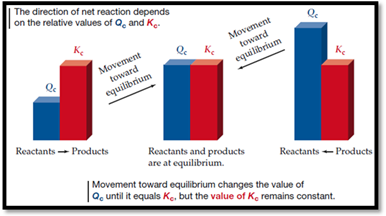
(a)
Interpretation:
The reaction quotient of given reaction has to be calculated. Also the direction of reaction to reach equilibrium has to be predicted.
Concept introduction:
Reaction quotient (Q):
Reaction quotient (Q) is the ratio of product of concentration of products to that of product of concentration of reactants, raised to the power of coefficients.
Consider a reaction
Where,
a, b, c and d are coefficients of each species.
t is arbitrary time for measuring concentration .

Figure 1
(b)
Interpretation:
At equilibrium the molar concentrations of
Concept introduction:
Calculation of equilibrium concentration from initial concentration:
- The balanced equation for given reaction has to be written.
- Set up an equilibrium table to calculate x value
- The value of x is solved by substituting concentrations of chemical species in equilibrium constant expression.
- The concentration of chemical species at equilibrium is calculated from value of x
Equilibrium constant
Equilibrium constant
Consider the reaction where A reacts to give B.
On rearranging,
Where,
Want to see the full answer?
Check out a sample textbook solution
Chapter 13 Solutions
General Chemistry: Atoms First
- The equilibrium constant for the butane iso-butane equilibrium at 25 C is 2.50. Calculate rG at this temperature in units of kJ/mol.arrow_forwardShow that the complete chemical equation, the total ionic equation, and the net ionic equation for the reaction represented by the equation KI(aq)+I2(aq)KI3(aq) give the same expression for the reaction quotient. KI3 is composed of the ions K+ and I3-.arrow_forwardWhat is the approximate value of the equilibrium constant KP for the change C2H5OC2H5(l)C2H5OC2H5(g) at 25 C. {Vapor pressure was described in the previous Chapter on liquids and solids; refer back to this chapter to find the relevant information needed to solve this problem.)arrow_forward
- Methanol can be synthesized by means of the equilibriumreaction CO(g)+2H2(g)CH3OH(g) for which the equilibrium constant at 225°C is 6.08103. Assume that the ratio of the pressures of CO(g) and H2(g) is 1:2. What values should they have if the partial pressureof methanol is to be 0.500 atm?arrow_forwardIf wet silver carbonate is dried in a stream of hot air. the air must have a certain concentration level of carbon dioxide to prevent silver carbonate from decomposing by the reaction Ag2CO3(s)Ag2O(s)+CO2(g) H for this reaction is 79.14 kJ/mol in the temperature range of 25 to 125C. Given that the partial pressure of carbon dioxide in equilibrium with pure solid silver carbonate is 6.23 103 torr at 25C, calculate the partial pressure of CO2 necessary to prevent decomposition ofAg2CO3 at 110C. (Hint: Manipulate the equation in Exercise 79.)arrow_forwardFor the system 2SO3(g)2SO2(g)+O2(g) K=1.32 at 627. What is the equilibrium constant at 555C?arrow_forward
- For the system SO3(g)SO2(g)+12 O2(g)at 1000 K, K=0.45. Sulfur trioxide, originally at 1.00 atm pressure, partially dissociates to SO2 and O2 at 1000 K. What is its partial pressure at equilibrium?arrow_forwardAt a certain temperature, K=0.29 for the decomposition of two moles of iodine trichloride, ICl3(s), to chlorine and iodine gases. The partial pressure of chlorine gas at equilibrium is three times that of iodine gas. What are the partial pressures of iodine and chlorine at equilibrium?arrow_forwardAt 1100 K, KP = 0.25 for the reaction 2SO2(g)+O2(g)2SO3(g) Calculate the equilibrium partial pressures of SO2, O2, and SO3 produced from an initial mixture in which PSO2=PO2=0.50atm and PSO3=0. (Hint: If you don t have a graphing calculator, then use the method of successive approximations to solve, as discussed in Appendix 1.4.)arrow_forward
- At 1 atm and 25 C, NO2 with an initial concentration of 1.00 M is 3.3103 decomposed into NO and O2. Calculate the value of the equilibrium constant for the reaction. 2NO2(g)2NO(g)+O2(g)arrow_forward7-64 As we shall see in Chapter 20, there are two forms of glucose, designated alpha and betawhich are in equilibrium in aqueous solution. The equilibrium constant for the reaction is 1.5 at 30°C. (a) If you begin with a fresh 1.0 M solution of D-glucose in water, what will be its concentration when equilibrium is reached? (b) Calculate the percentage of glucose and of glucose present at equilibrium in aqueous solution at 30°C.arrow_forward
 Chemistry: The Molecular ScienceChemistryISBN:9781285199047Author:John W. Moore, Conrad L. StanitskiPublisher:Cengage Learning
Chemistry: The Molecular ScienceChemistryISBN:9781285199047Author:John W. Moore, Conrad L. StanitskiPublisher:Cengage Learning Introduction to General, Organic and BiochemistryChemistryISBN:9781285869759Author:Frederick A. Bettelheim, William H. Brown, Mary K. Campbell, Shawn O. Farrell, Omar TorresPublisher:Cengage Learning
Introduction to General, Organic and BiochemistryChemistryISBN:9781285869759Author:Frederick A. Bettelheim, William H. Brown, Mary K. Campbell, Shawn O. Farrell, Omar TorresPublisher:Cengage Learning Chemistry by OpenStax (2015-05-04)ChemistryISBN:9781938168390Author:Klaus Theopold, Richard H Langley, Paul Flowers, William R. Robinson, Mark BlaserPublisher:OpenStax
Chemistry by OpenStax (2015-05-04)ChemistryISBN:9781938168390Author:Klaus Theopold, Richard H Langley, Paul Flowers, William R. Robinson, Mark BlaserPublisher:OpenStax Principles of Modern ChemistryChemistryISBN:9781305079113Author:David W. Oxtoby, H. Pat Gillis, Laurie J. ButlerPublisher:Cengage Learning
Principles of Modern ChemistryChemistryISBN:9781305079113Author:David W. Oxtoby, H. Pat Gillis, Laurie J. ButlerPublisher:Cengage Learning Chemistry for Engineering StudentsChemistryISBN:9781337398909Author:Lawrence S. Brown, Tom HolmePublisher:Cengage Learning
Chemistry for Engineering StudentsChemistryISBN:9781337398909Author:Lawrence S. Brown, Tom HolmePublisher:Cengage Learning Introductory Chemistry: A FoundationChemistryISBN:9781285199030Author:Steven S. Zumdahl, Donald J. DeCostePublisher:Cengage Learning
Introductory Chemistry: A FoundationChemistryISBN:9781285199030Author:Steven S. Zumdahl, Donald J. DeCostePublisher:Cengage Learning





